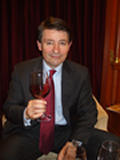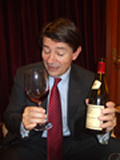It is always exciting to meet a producer from Burgundy and when Subhash Arora was invited to chat with Pierre-Henry Gagey, President of Louis Jadot transiting through Delhi on his way to Bhutan, he was delighted to see him and taste some of their wines too.
 I had last met Pierre-Henry at the Taj Mahal hotel a couple of years ago and was impressed by his passion for Burgundy where he was born and grew up. It was a pleasure to catch up with him and learn about the current vintages of Burgundy over tastings of a Puligny Montrachet 2006, Morgon 2001 (Cru Beaujolais) and Gevry Chambertin 2006 I had last met Pierre-Henry at the Taj Mahal hotel a couple of years ago and was impressed by his passion for Burgundy where he was born and grew up. It was a pleasure to catch up with him and learn about the current vintages of Burgundy over tastings of a Puligny Montrachet 2006, Morgon 2001 (Cru Beaujolais) and Gevry Chambertin 2006
What is your background and how long have you been associated with the company?
I am a Burgundian by birth, born in Beaune. My family has had 200 years of wine experience from both my parents’ side. My father joined the company in 1954 as Monsieur Jadot’s apprentice and later took charge and helped the company buy several vineyards and expand. I joined in 1985, the year it was sold to the current owners and took charge from my father in 1991.
Aman Dhall tells me you are celebrating 150 years?
Yes, our company was founded in 1859 by the Jadot family, same year as Gaja in Italy. Madame Jadot sold it to the Kopf family of New York in 1985 as she was getting old and her daughters were not interested in running the company. It helped that Kobrand, owned by the Kopf family was already distributing Louis Jadot in the US and it had become a national brand by the time they bought it.
How much area do you have under vine and what is your production?
We own about 75 hA in Cot d’Or in Burgundy and 75 hA in Beaujolais. Our production quantity varies with the vintage. But I’d say on the average we produce about 8 million bottles.
That’s a big number. How do you get enough grapes?
As you know we produce all four levels of Burgundy wines- Grand Crus, Premier Crus, Village appellation and the generic wines. The first two are made with 80% grapes from our vineyards; the rest are produced from grapes we buy from about 400 growers. 70% of the grapes for our wines come from them.
Doesn’t it create a problem in quality?
In burgundy we work in a family tradition way. We have growers working with us for the last many years, some for as long as 50 years. They know the quality has to be maintained for them and us to stay in business. But in Burgundy we don’t supervise the farming and the growers do not like interference. We do tell them in subtle ways if there are any problems or suggestions. They know if they do not maintain quality they may not be with us for long. But we do not have any written contracts- all our commitments are oral and it works fine.
Then how do you settle the prices?
We negotiate prices with growers every vintage based on the quality and what the market decides as a benchmark. A few of the bigger companies including us decide the benchmark price for every vintage. decide the benchmark price for every vintage.
Eventually, it is the mutual trust which is very important. For instance, some of our 2008 are already being bottled but we still have not decided on the grape prices. I had to take this sojourn for a 2-week trek in Bhopal, so we will settle the rates when I go back. Of course, we have already started to make them payments in account.
What is your pricing strategy for various classifications?
It is difficult to remember pricing for different villages but as a rule of thumb if the Grand Cru sells for 100, then the Premier Cru would sell for 50, village for 30 and the generic Burgundy for 15. Of course, this is our system and varies from village to village. Other producers may price them differently.
Also to consider is the fact that we declassify our wines too- which due to negative implication at times is referred to as replier in France. Only the top quality wine is used for the Grand Cru; what is not good enough in our view is mixed with the village wines. The percentage and the quantity vary with the vintage, of course. For instance, 2005 was an excellent vintage so there was no need for any replier whereas for 2006 we used 30% of Grand Cru in Gevry Chambertin we taste today.
Similarly, in Beaujolais we may replier a part of the Crus Beaujolais into Beaujolais Village as we own the vineyards.
Different producers have different policies on this but the smaller winegrowers cannot afford to do it so all the grapes from that appellation would be used to make that particular wine.
Which are your export markets?
We export primarily to the US, UK, Canada, Japan and Germany. China has been growing too. India is of course, on our radar and we are happy to see our wines listed by all the leading hotels.
The US is a very important market for us because that is one market that really appreciates quality and is willing to pay for it. Ask Angelo Gaja, Symington Family Port, any champagne house or any producer of quality wine, they would tell you that the US is their most important market.
What do you think of Burgundy 2008 vintage?
I would say it would be good to very good. It gave us scare because it rained heavily in August. But the sun came out on 13th September; I clear remember the date as it was a Saturday and I had returned from my vacation home in Italy. We were at a party in which many producers were there. It was raining so heavily that we gave up on the crop; the only thing that could save the disaster would be sun, warmth and strong winds during the next 3-4 weeks.
We were really lucky. The sun came out the very next day and it was warm and sunny during the next 4 weeks till the harvest. The grapes ripened well though I feel there might be some dilution in the juice. Although a bit early to tell, we are keeping our finger crossed and hope it would be good vintage.
What is your opinion about En Primeur 2008?
Well, the Burgundy does not generally get involved with it. Bordeaux has a different distribution channel-through negociants; they do not sell directly and need to get some cash early. They sell part of the same wine later at higher prices. In Burgundy, we have a proper distribution system which we control and nurture ourselves. For instance, in India we have Brindco with whom we work directly. Besides, we sell all the wine we produce. We do have a system of reservation by which we reserve wine against orders without taking advance.
 Has the current recession affected your business? Has the current recession affected your business?
We are definitely affected by it across all our markets. Many people try to hide facts and keep brave faces by saying they have been spared. The total quantity of wine consumption may not have been affected. But people are trading down. Those who were drinking $50 wine are now drinking $30 bottle.
I was in the US recently where people are drinking more from their cellars rather than buying fresh. They say we will refill our cellar next year when things get better. One of the biggest retailers on the East Coast, Zachys told me that they were selling same volumes but values had come down by about 20%. People are drinking less in the restaurants and more at home.
Distributors are reducing their inventories. For instance, if they kept 3 month inventory earlier, they have reduced to one month. What I would like to say is that our flow is not the same as before. But we are maintaining our production and let the inventory increase so that when economy improves, we should be able to liquidate it.
Do you recommend decanting your wines?
Our younger wines should be decanted including the whites. If you can keep the temperature constant, I would say they should be kept in the glass. Young red should also be decanted to let them open out a little. Older burgundies need not be decanted and should be left in the glass for a while to appreciate the complexities.
What do you think of the recent hullaballoo about wine and cancer?
I read about it recently in a French newspaper too. This is really ridiculous. We call these people creating the scared as SAE- ‘self appointed experts’. It is a highly irresponsible statement to make without any proper verification. We know wine in moderation is good for health.
What are your comments about the 2006 vintages we are tasting?
The Puligny Montrachet 2006 we are tasting was bottled a year ago. It has fresh acidity and is complex. In Burgundy, we want energy, life in the wine. It has to be sharp, precise and lively. We do not want it to be rich and powerful like chardonnays from other countries. A Burgundy white needs to be mineral and should last 15-20 years though it may be enjoyed in its different stages of evolution. This was a god vintage. be sharp, precise and lively. We do not want it to be rich and powerful like chardonnays from other countries. A Burgundy white needs to be mineral and should last 15-20 years though it may be enjoyed in its different stages of evolution. This was a god vintage.
The Gevry Chambertin is a lighter wine, quite aromatic and elegant. I like the purity of this vintage where the Pinot Noir is expressing itself. In Burgundy, there are the village, vintage and Pinot Noir which express their identity as the time goes by. This one is easier and earlier drinking wine which would be ready before 2005 because of the lower tannins.
Our job is always to let the wine express the soil rather than our ego as the winemaker trying to change its style and I think 2006 has done very well.
But as I always tell people, ‘trust your own taste.’ We are there to guide you but in the end everyone has a different palate and one need not follow any advice strictly.
What do you think of screw caps?
Well, some of the producers in Burgundy and Beaujolais are already using them now. Our customers in the UK want some of our wines, especially from Beaujolais to be screw-capped. We are not against the young wines to be in these enclosures. But for our red Burgundy, I don’t think we want to switch from the cork. We use the best possible corks for our higher end wines. For the generic wines we use the pressed cork which does not create the taint.
One last question. Why is your business card in a magnum size?
(laughing) Only because of the tradition in our family. Even my father used to have the same big size card and I never changed the size, though inconvenient to carry. In Japan, our distributor prints cards for me in Japanese and in much smaller size.
After a warm and sincere invitation from Pierre-Henry Gagey to visit him in Bourgogne, I split, with fond memories of the wonderful region of France known for its elegant and feminine wines, where wine from one vine row to the other can be different and the complexity of wines can be matched only by the complex system of classification of vineyards and where the producer is more important than the winemaker because of its history and tradition and where I treaded the same path the late Mrs. Indira Gandhi did decades ago.
Subhash Arora
March 13, 2009 |